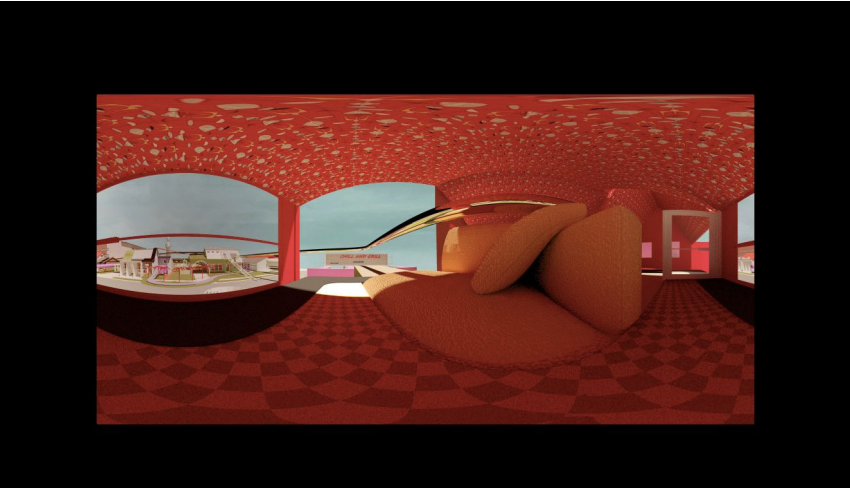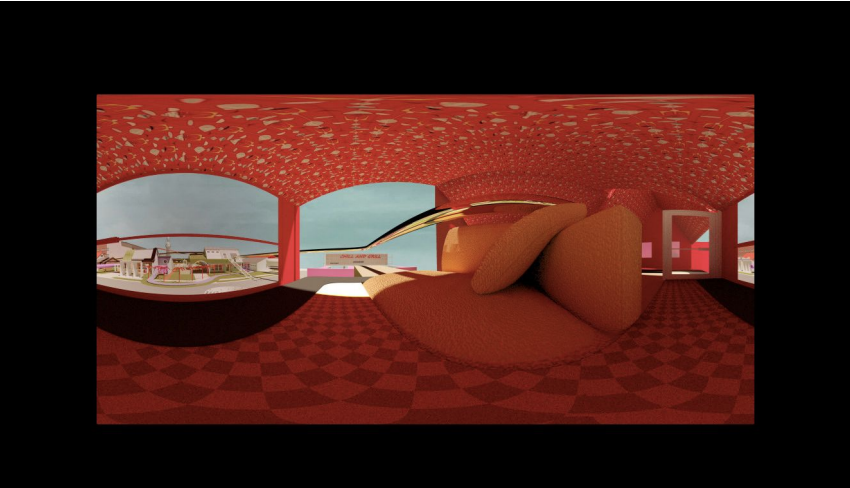Faculty are embracing new learning tools and methods this year, taking advantage of technology and the flexibility of different modes of course delivery to achieve academic goals, and fostering collaboration among their students in novel and exciting ways.

A frame from a 360-degree digital experience designed by Alejandra Sanchez Tata and Susana Chinchilla, both BArch ’20, that was part of their digital thesis presentation for Michele Gorman and Adam Elstein’s Architecture and Magic studio.
Faculty are embracing new learning tools and methods this year, taking advantage of technology and the flexibility of different modes of course delivery to achieve academic goals, and fostering collaboration among their students in novel and exciting ways.
“New modes of teaching and learning were already underway at Pratt, but the pandemic has really catalyzed and accelerated the pace of change,” said Donna Heiland, Vice Provost for Academic Affairs. “The essential focus, as always, is on achieving educational goals, but there are multiple ways of getting there. Online and hybrid formats, real-time as well as asynchronous instruction, hands-on learning experiences, and more are offering diverse pathways to those goals, increasing flexibility and access for our students and expanding teaching modalities for our faculty. This is a generative time for Pratt, and the work we’re doing now ensures not only our success in this moment, but our ability to keep growing and changing over time.”
One example is in the Foundation department, which moved fully online this fall. Organized into tight learning cohorts taught by faculty teams working together, School of Art and School of Design students starting their Foundation year will have exciting ways to build community with each other as they develop the essential skills that will underpin the rest of their undergraduate education.
Across an array of disciplines from architecture to fine arts, communications design, and interior design, faculty members have been rethinking reviews and modes of critique, a central element of many courses at Pratt. These efforts include developing new opportunities in the digital space to expose students to a broader range of professional practitioners for reviews of their work, and examining different ways of discussing work in progress.
Another example is in the Math and Science department, where students are conducting remote lab-based work to learn about science using Learning Kits conceived by Professor Cindie Kehlet over the summer term. The lab work is asynchronous and done fully offline. “Some students really took the lab further than they would have been able to do within restricted class times,” Kehlet said. Each kit includes materials needed to participate in the course, making it accessible to students across the globe.
Supporting faculty in navigating new curricula and modes of course delivery is Pratt’s Center for Teaching and Learning (CTL), which works to promote a collaborative faculty community and offers pedagogical programs, tutorials, and other resources. “The CTL has created opportunities for faculty to come together in supportive learning cohorts to explore the potential of these new approaches to teaching and learning,” said its director, Judit Török. “We continue to assist and partner with faculty to help our community navigate the landscape of change and creative possibility.”
Technology is also playing a vital role in supporting new modes of teaching and learning. With the recent introduction of Pratt Launchpad (part of the new onePratt platform), students anywhere can access creative digital tools from any computer, leveling the playing field for access. Pratt has also adopted the robust learning management platform Canvas, as well as versatile tools such as the digital whiteboard Miro and Milanote apps, which offer any number of ways to present, organize, share, ideate, and collaborate on ideas and projects.
In this time of incredible transformation both in higher education and in the world, Pratt and its faculty will continue to innovate with pedagogical approaches and technologies that create multiple paths to academic excellence, increase access, and prepare students to achieve their full potential as they establish careers and work to shape the future.
